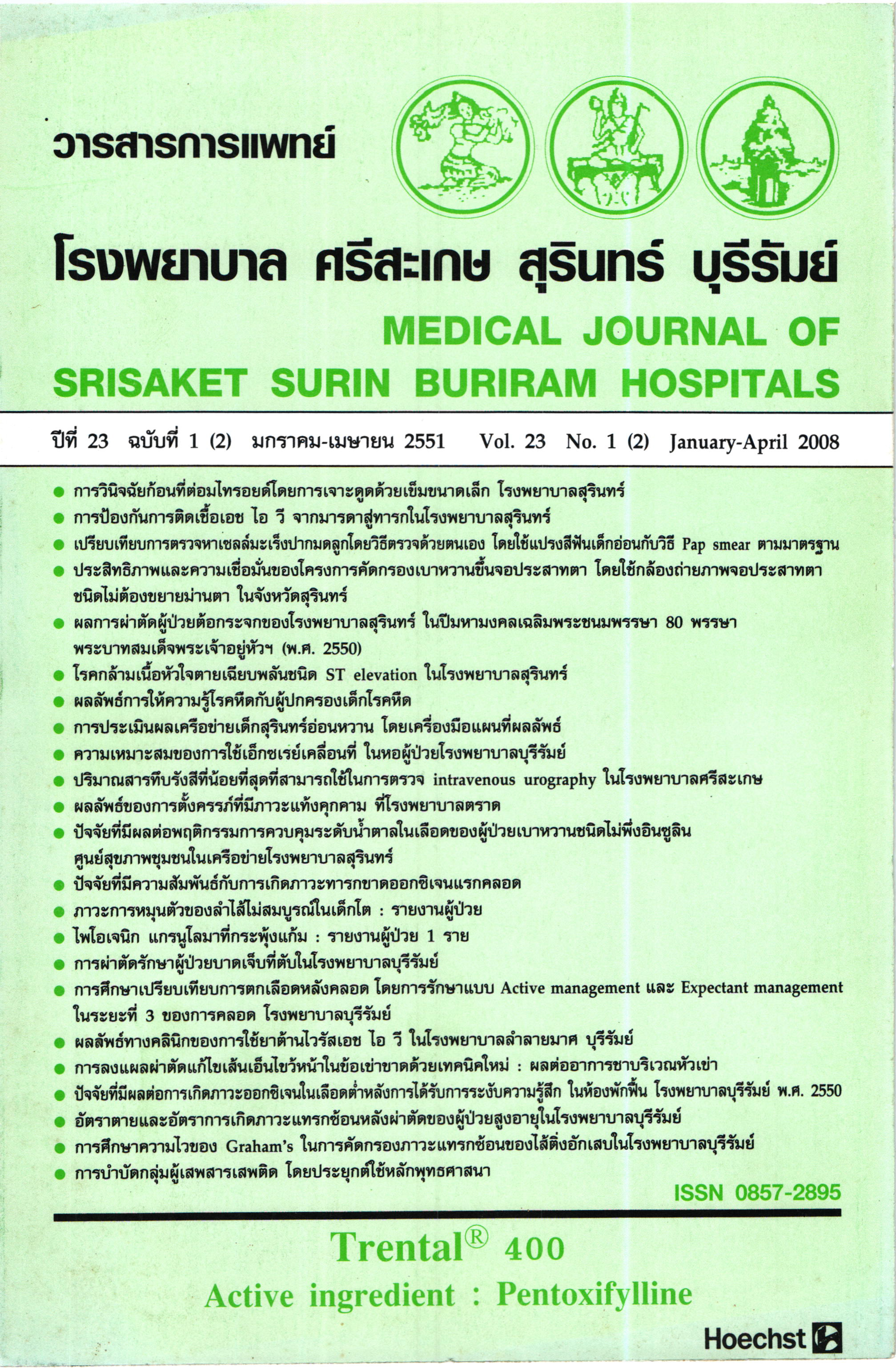ปริมาณสารทึบรังสีที่น้อยที่สุดที่สามารถใช้ในการตรวจ intravenous urography ในโรงพยาบาลศรีสะเกษ
Main Article Content
บทคัดย่อ
วัตถุประสงค์: เพื่อศึกษาปริมาณสารทึบรังสีที่น้อยที่สุดที่สามารถใช้ในการตรวจ intravenous urography รวมถึงเปรียบเทียบปริมาณสารทึบรังสีที่ใช้กับอัตราการแพ้สารทึบ รังสี
วิธีการศึกษา: ศึกษาย้อนหลังประวัติการประเมินผู้ป่วยก่อนการตรวจ intravenous urography การบันทึกสารทึบรังสีที่ใช้ และอุบัติการณ์การแพ้สารทึบรังสีในผู้ป่วยที่ส่งตรวจ intravenous urography ณ กลุ่มงานรังสีวิทยา โรงพยาบาลศรีสะเกษ ในระหว่าง 1 ตุลาคม 2547 ถึง 30 กันยายน 2548 จำนวน 503 ราย
ผลการศึกษา: ผู้ป่วยเป็นชาย 257 ราย หญิง 246 ราย อายุ ระหว่าง 3 เดือน - 89 ปี ผู้ป่วย ทุกรายมีค่า creatinine น้อยกว่า 2 mg% พบว่ามีผู้ป่วยที่ได้รับปริมาณสารทึบ รังสีมากกว่าปริมาณที่ควรได้ตามน้ำหนักจำนวน 44 ราย มีอัตราการแพ้สารทึบ รังสี 4.54% และผู้ป่วยที่ได้รับปริมาณสารทึบสีน้อยกว่าที่ควรได้ตามน้ำหนักมี จำนวน 346 ราย มีอัตราการแพ้ 3.76% ผู้ป่วยน้ำหนักน้อยกว่า 60 กิโลกรัม ได้รับการฉีดสารทึบรังสีน้อยกว่าที่ควรได้ตามน้ำหนัก 1-15 ml. และผู้ป่วยที่น้ำหนักมากกว่า 60 กิโลกรัม ได้รับการฉีดสารทึบรังสีในปริมาณน้อยกว่าที่ควรได้ตามน้ำหนัก 16-35 ml.
สรุป: ในผู้ป่วยที่มีภาวะการทำงานของไตปกติการใช้ปริมาณสารทึบรังสีในปริมาณน้อยกว่าที่ควรได้ตามน้ำหนัก หรือน้อยกว่า 1 ml./kg. ก็เพียงพอต่อการวินิจฉัย สามารถลดต้นทุนและอุบัติการณ์ของการแพ้สารทึบรังสีมากกว่าการใช้ปริมาณ สารทึบรังสีที่มากกว่าปริมาณที่ควรได้ตามน้ำหนัก
Article Details
เอกสารอ้างอิง
2. Davidson, A. J., Hartman, D. S., Diagnostic uroradiologic techniques : radiologic of the kidney and urinary tract. 2 nd. ed. Philadephia : W.B. Saunders company ; 1994. p. 3-29.
3. Bush WH, Swanson DP. Acute reactions to intravascular contrast media : type, rish fators, recognition, and specific treatment. AJR Am J Roentgenol. Dec 1991;157(6):1153-61.
4. Cohen MD . Intravenous urography in neonates and infants. What dose of contrast should be use?. BJR 1979;52:942-44.
5. Maddox, T.G. Adverse Reaction to Contrast Meterial : Recognition, Prevention, and Treatment. Am Fam Phsician. Oct. 2002;66(7):1229-34.
6. Becker C. Prophylaxis and treatment of side effects due t iodinated contrast media relevant to radiological practice. Radiologe. Sep 2007;47(9):768-73.
7. Cohan RH, Ellis JH. Iodinated contrast material in uroradiology. Choice of agent and management of complications. Urol Clin North Am 1997;24:471-91.


